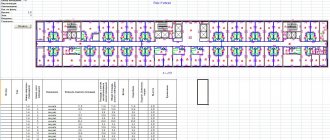On January 1, 2021, the federal accounting standard “Long-term contracts”, approved by Order of the Ministry of Finance of Russia dated June 29, 2018 No. 145n (hereinafter referred to as Standard No. 145n), comes into force. The Ministry of Finance of Russia, by letter dated October 28, 2019 No. 02-06-07/84752, communicated methodological recommendations for the application of this standard to participants in the budget process. However, to understand the nuances of classifying contracts, you will need knowledge of the provisions of other federal accounting standards.
Recommendations
Methodological recommendations for the application of Standard No. 145n are set out by the Ministry of Finance on 18 pages, half of which are explanations for reflecting transactions under construction contracts in accounting.
But public sector institutions rarely act as contractors. Therefore, for most state and municipal institutions, only sections I and III of the Methodological Recommendations will be the most relevant. Section I of the Methodological Recommendations reveals the general provisions for the application of Standard No. 145n, and Section III provides explanations on the recording of transactions for the conclusion and execution of other long-term contracts. In addition, Section IV of the Guidelines contains transitional provisions of the standard when it is first applied.
The Russian Ministry of Finance published these Methodological Recommendations in a very timely manner, since institutions need to do a lot of preparatory work by the end of this year 2021.
Lease term and lease term
Nevertheless, it should be taken into account that in judicial practice there is a position according to which the lease agreement is recognized as concluded from the moment of transfer of property (clause 2 of Article 433 of the Civil Code of the Russian Federation) and is called a real contract. With this approach, the beginning of the contract term will coincide with the beginning of the lease term. However, the more common position is that the lease agreement is consensual.
However, the start dates of these periods may vary. For example, if the property is transferred a few days after the parties sign the contract, then the contract period will begin to run from the moment it is signed, and the lease period will begin from the moment the property is transferred. This situation is possible, since the lease agreement is recognized by most courts as consensual and, in accordance with paragraph 1 of Art. 425, paragraph 1, art. 433 of the Civil Code of the Russian Federation is considered concluded from the moment the acceptance is received by the person who sent the offer, in particular, from the moment the contract is signed by both parties.
Before the reporting date
In Section IV of the Methodological Recommendations, the Russian Ministry of Finance recommends conducting an inventory of contracts concluded before January 1, 2021 and continuing to be valid after this date. The purpose of such an inventory is to analyze contracts for compliance with the criteria for their recognition as long-term in accordance with the requirements of Standard No. 145n. The results of the inventory will become the basis for the formation of incoming (as of 01/01/2020) balance sheets for the corresponding accounts of settlements and income. This section of the Methodological Recommendations of the Russian Ministry of Finance provides the corresponding correspondence of accounts both in the presence of concluded construction contracts and other long-term contracts.
Note! Standard No. 145n establishes only uniform requirements for the procedure for recording business transactions arising as a result of the conclusion and execution of contracts and paid services, the validity of which exceeds one year. Therefore, the institution in its accounting policy has the right to specify some qualifications of such contracts.
For example, the Ministry of Finance of Russia in its Methodological Recommendations indicates that the accounting policies of the institution should reflect :
- conditions for accepting for accounting income and other accounting items arising from the conclusion and execution of work contracts, paid services, the validity of which does not exceed one year, but the start and end dates of execution of which fall on different reporting periods;
- the procedure for calculating income from sales under a long-term contract in the event of its uneven execution.
To implement these provisions of the accounting policy in 2021, it is necessary to develop primary accounting documents, set deadlines for submitting the necessary information to the accounting department and appoint responsible persons, and make appropriate adjustments to the document flow schedule.
The inventory of contracts and approval of the conditions for their classification in the accounting policy must occur before the end of the current year. However, the implementation of the requirements of Standard No. 145n will not end there.
The procedure for recognizing income and expenses under long-term construction contracts
Section 2 of the methodological recommendations of the Ministry of Finance on the application of the standard discusses in detail the main provisions and reflection of business transactions when concluding a construction contract. When accounting for income and expenses under this agreement, the institution should pay attention to the following points:
- When concluding a long-term construction contract, deferred income is not accrued.
- Income under a concluded construction subcontract agreement is calculated by the institution at the end of each reporting period, based on the following formula:
D=CDD*%isp –DPr,where D is income under a long-term construction contract; TsDD – the price of a long-term construction contract; %sp – percentage of contract fulfillment at the end of the reporting period; DPR – previously recognized income under a construction contract.
The procedure for determining the percentage of fulfillment of obligations under a construction contract must be fixed by the institution in its accounting policies.
- Expenses under a long-term construction contract are reflected as follows:
- Expenses provided for by the estimate in the current reporting period are included in the cost of the work (services) provided and are reflected in the debit of account 0 109 60 2ХХ “Direct costs for the manufacture of finished products, performance of work, provision of services” in correspondence with the settlement account.
- Expenses provided for in the estimate, incurred in the reporting period in connection with upcoming work, are not included in the cost of work (services) provided and are reflected in the debit of account 0 401 50 2ХХ “Future expenses” in correspondence with the settlement account.
Expenses incurred in the current reporting period in excess of the estimate are not included in the cost of work (services) provided and are reflected in the debit of account 0 401 20 2ХХ “Expenses of the current financial year” in correspondence with the accounting and settlement account.
To implement this area of the standard, the Methodological Recommendations justify the use of the following accounts:
- analytical accounting account 0 205 38 000 “Calculations of income from completed stages of work under a construction contract” used to reflect income to be presented in connection with the implementation of a long-term construction contract;
- off-balance sheet account 45 “Income and expenses under long-term construction contracts” used to record the result of the execution of a long-term contract.
These accounts have not yet been included in Instruction 157n, which most likely should be implemented in the future.
Forerunner
Note that the contracts themselves, whatever they may be (short-term or long-term), are not objects of accounting.
Such agreements are the basis for the emergence of assets (accounts receivable) or liabilities (accounts payable). Therefore, the classification of contracts as long-term or short-term is a kind of precursor to accounting for the corresponding asset or liability. Clause 2 of Standard No. 145n states that it is applied simultaneously with the “Conceptual Framework” standard, approved by Order of the Ministry of Finance of Russia dated December 31, 2016 No. 256n (hereinafter referred to as Standard No. 256n). Standard No. 256n in paragraph 39 states that for accounting purposes... a liability is debt arising as a result of the facts of economic life, the repayment of which will lead to the disposal of assets containing useful potential or economic benefits. This definition of liability corresponds to accounts payable. Unfortunately, there is no explanation of what is meant by accounts receivable in Standard No. 256n. And the concept of “asset”, according to paragraph 36 of Standard No. 256n, applies only to property.
Fortunately, in the standard “Presentation of Accounting (Financial) Statements”, approved by Order of the Ministry of Finance dated December 31, 2016 No. 260n (hereinafter referred to as Standard No. 256n), you can find more useful information. Note that Standard No. 260n also applies simultaneously with the Conceptual Framework standard, so it is obvious that its provisions are applicable to understanding Standard No. 145n. In addition, in accordance with paragraph 3 of Standard No. 145n, it is used when reflecting in accounting income, expenses, facts of economic life, and other accounting objects arising as a result of the conclusion by the accounting entity of contract agreements, paid services, the validity of which exceeds one year (hereinafter - long-term contracts)…, as well as when disclosing information about such accounting items in accounting (financial) statements, unless otherwise established by other federal accounting standards for public sector organizations. Therefore, when studying the provisions of Standard No. 145n, the accountant needs to take into account the requirements of Standard No. 260n.
Note! According to paragraph 25 of Standard No. 260n, assets and liabilities in the balance sheet are presented as divided into long-term (non-current) and short-term (current).
At the same time, paragraph 26 of Standard No. 260n provides a definition of a short-term asset. One of the criteria for classifying a short-term asset is that it is intended for consumption, transfer (sale) or conversion into cash (other assets) within 12 months after the reporting date. The same paragraph further states that all other assets of the reporting entity, that is, consumed over 12 months, including tangible, intangible and financial assets, are classified as long-term.
In other words, short-term assets arise on the basis of short-term contracts (liabilities are valid for up to one year), and long-term assets are created on the basis of long-term contracts (liabilities are valid for MORE than one year).
And one moment! All in the same paragraph 26 of Standard No. 260n it is clarified that short-term assets include inventories, accounts receivable and other assets that can be consumed, transferred (sold) or converted into cash within 12 months after the reporting date, even if their disposal is not expected during this period. The peculiarities of accounting for receivables are also discussed in paragraph 11 of Standard No. 145n: upon signing another long-term agreement... the accounting entity reflects settlements with debtors on sales income for the entire term of the long-term agreement in correspondence with balance sheet accounts accounting for future income.
To sum up the interim result, we can build the following logical chain: Standard No. 145n establishes the conditions for recognizing contracts as long-term - on the basis of a long-term agreement, long-term (non-current) assets arise - the procedure for reflecting long-term (non-current) and short-term (current) assets in the financial statements is established by Standard No. 260n. At the same time, according to paragraph 5 of Standard No. 145n, the reflection in accounting of income and other accounting objects arising as a result of the conclusion and execution by the accounting entity of work contracts, paid services, the validity of which does not exceed one year - that is, short-term (current) assets! - but the start and end dates of execution of which fall on different reporting periods are carried out in accordance with the provisions of the Standard in cases provided for by the accounting policy of the accounting entity.
Question in the section: For what period is a contract for the provision of paid services concluded?
An agreement for the provision of paid services is a civil law agreement, since the relations of the parties to such an agreement are regulated not by the Labor Code of the Russian Federation, but by the Civil Code of the Russian Federation, according to which the term of the agreement is its essential condition. In other words, a civil contract cannot be concluded for an indefinite period; it must be urgent. However, the Civil Code of the Russian Federation does not establish time limits, therefore neither the minimum nor the maximum limit for the duration of a civil contract has been established.
We recommend reading: VAT refund when buying an apartment
The validity period of a civil law contract is determined by the parties to the contract themselves. But, given that the contract for the provision of paid services is concluded for the period of provision of certain, specific services, its duration must correspond to the volume of services ordered to the contractor.
After the reporting date
In the coming 2021, the institution will keep records of accounts receivable under long-term and short-term contracts within the framework of the accounting policy approved for this year. In this case, the main task of the accountant will be to reflect in the accounting accounts, no later than the month following the signing of a long-term agreement, settlements with debtors for sales income for the entire period of validity of such an agreement. This is done with an account (clause 11 of Standard No. 145n):
- Debit 0 20531 56Х “Increase in accounts receivable for income from paid services (work), cost compensation”
- Credit 0 40140 131 “Deferred income from paid services (work)”
Then, during the year, as the terms of the contract are fulfilled, the institution includes part of the “future” income in the income of the reporting period. Section III of the Methodological Recommendations states that the recognition of income from the provision of services (work) under other long-term contracts as income of the current financial year is carried out in one of the following ways:
- evenly (monthly) until the expiration of another long-term contract;
- in the manner prescribed by the accounting policy of the accounting entity, if the performance of work (provision of services) under another long-term contract is carried out unevenly.
Everything seems to be clear.
But in paragraph 27 of Standard No. 260 there is an indication that short-term assets also include the current share of long-term financial assets, that is, part of the entity’s long-term financial assets that are subject to repayment within 12 months after the reporting date.
It seems that the provisions of Standard No. 145n and Standard No. 260n only complement each other. During the year, a contract classified before the reporting date is executed, settlements are made and a short-term asset is formed. And when preparing financial statements, the “current” share of long-term assets, that is, subject to repayment during the reporting year, is considered as a short-term asset. But how convenient and understandable such a scheme will be for accountants of public sector institutions will become clear only next year.
It may be that a simpler solution would be to classify the "current portion" of long-term receivables as a current asset immediately after the reporting date. This would significantly simplify the work of accountants and would not affect the reporting figures in any way. It is possible that, having studied the experience of accounting and reporting, after some time the Ministry of Finance will prepare appropriate clarifications. In the meantime, accountants should take a more careful and thoughtful approach to the formation of accounting policy provisions for 2020.
Maximum contract duration
For certain types of contracts, the law may establish maximum (limit) terms for the validity
of the contract. An agreement concluded for a period exceeding the maximum period is considered concluded for a period equal to the maximum. For example, a rental agreement by virtue of clause 1 of Art. 627 of the Civil Code is concluded for a period of up to one year. According to Art. 683 of the Civil Code, a residential lease agreement is concluded for a period not exceeding five years. If such an agreement does not specify a period, the agreement is considered to be concluded for five years.
In cases provided for by the Civil Code, the validity period of the contract may be considered an essential term of the contract and its absence leads to the recognition of the contract as not concluded. For example, the validity period is recognized as an essential condition of an insurance contract (Article 942 of the Civil Code), a contract of trust management of property (clause 1 of Article 1016 of the Civil Code).
How to conclude an agreement?
A written agreement is required, even if the property is rented out to friends. Then it will be easier to resolve controversial issues if they arise.
A lease agreement is different from a rental agreement. In the first case, this is a transaction in which one or both participants are legal entities (Chapter 34 of the Civil Code of the Russian Federation). The second option involves an agreement between individuals (Chapter 35 of the Civil Code of the Russian Federation).
To correctly draw up an agreement, you can seek the help of a lawyer. Notarization of the document is not required, but is possible upon request. This does not affect the legal validity of the papers. A prerequisite for the validity of the agreement is its signing by both parties.
At the same time, an act of acceptance and transfer of housing must be drawn up . It indicates the technical condition of the premises: the presence or absence of repairs, plumbing, household appliances and furniture. The condition of each item, name, make and model, and estimated cost are also indicated.
The deed is signed by both parties, only after which the keys can be handed over to the tenant.
We do not recommend completing the documents yourself. Save time - contact our lawyers by phone:
8 (800) 302-76-94
Drawing up an agreement
The lease agreement must contain the following information:
- date and place of compilation;
- personal data of participants;
- subject of the contract;
- validity;
- rights and obligations of the parties;
- additional conditions;
- termination procedure.
We do not recommend completing the documents yourself. Save time - contact our lawyers by phone:
8 (800) 302-76-94
Maximum duration of a commercial lease agreement
- The scope of the agreement must be determined: state or non-state housing stock. In the first case, the lease is of a social nature and is concluded on the basis of a corresponding decision of the government authority. If the fund is non-state, the contract is a mutual agreement.
- Both legal entities and individuals have the right to conclude such an agreement. At the same time, they must be given ownership rights to the proposed real estate, or other capabilities that allow them to carry out such operations. And, unlike the tenant, who can have any citizenship, the landlord can only be citizens of the Russian Federation.
- The main difference is that a commercial rental agreement for residential premises is concluded for a period previously agreed upon by the parties.
- This type of agreement limits the tenant's rights.
- There are no requirements regarding the size of the premises to be rented.
- The amount of remuneration for the use of real estate is determined by the parties and is fixed in the agreement. If the law provides for a maximum amount of such payment, then the amount in the contract should not exceed it.
As for social rent, it ensures the stability of housing legal relations and guarantees the implementation of the rights of citizens to receive housing from the state. In addition, this feature reflects its social and consumer function. The urgency of the contract, in turn, indicates the commercial nature of the document under consideration.
We recommend reading: Unemployment Benefit in 2021 in Shchelkovo










